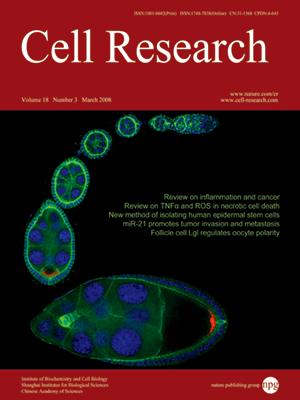
Volume 18, No 3, Mar 2008
ISSN: 1001-0602
EISSN: 1748-7838 2018
impact factor 17.848*
(Clarivate Analytics, 2019)
Volume 18 Issue 3, March 2008: 372-384
ORIGINAL ARTICLES
Lethal(2)giant larvae is required in the follicle cells for formation of the initial AP asymmetry and the oocyte polarity during Drosophila oogenesis
Qi Li, Tianchi Xin, Wenlian Chen, Mingwei Zhu and Mingfa Li
Laboratory of Developmental Genetics, Bio-X Life Science Research Center and School of Life Science and Biotechnology, Shanghai Jiao Tong University, Shanghai 200240, China
Correspondence: Mingfa Li(mfli@sjtu.edu.cn)
The intricately regulated differentiation of the somatic follicle cell lineages into distinct subpopulations with specific functions plays an essential role in Drosophila egg development. At early oogenesis, induction of the stalk cells generates the first anteroposterior (AP) asymmetry in the egg chamber by inducing the posterior localization of the oocyte. Later, the properly specified posterior follicle cells signal to polarize the oocyte along the AP and dorsoventral (DV) axes at mid-oogenesis. Here, we show that lethal(2)giant larvae (lgl), a Drosophila tumor suppressor gene, is required in the follicle cells for the differentiation of both stalk cells and posterior follicle cells. Loss-of-function mutations in lgl cause oocyte mispositioning in the younger one of the fused chambers, due to lack of the stalk. Removal of lgl function from the posterior follicle cells using the FLP/FRT system results in loss of the oocyte polarity that is elicited by the failure of those posterior cells to differentiate normally. Thus, we provide the first demonstration that lgl is implicated in the formation of the initial AP asymmetry and the patterning of the AP and DV axes in the oocyte by acting in the specification of a subset of somatic follicle cells.
Cell Research (2008) 18:372-384. doi: 10.1038/cr.2008.25; published online 12 February 2008
FULL TEXT | PDF
Browse 2032


